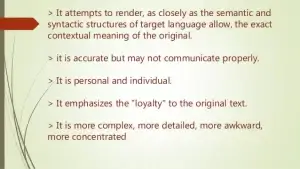Language skill, not only includes speaking, listening, writing and reading, but also translation. It is very important in the case of technology and book of science because mostly they are in a foreign language. In order to have a good translation from SL to TL, the translator needs to translate both words to the word and semantics. He must be able to combine both the meanings and achieve a better translation. Let us have a look at the characteristics of both communicative and semantic translations.
Theoretically, communicative translation presented itself individually to the secondary reader who does not face obscurities or difficulties, and also expect the liberal transfer of elements into his culture and language where necessary. Communicative translation is considered to be simpler, smoother, clearer, more direct, conventional, tending to under-translate and conforming to a specific register of language.
Usually, communicative translation puts emphasis on the shift of messages. The method pays attention to the listener or reader of TL and hopes that it does not contain any difficulty in the text of the target language.
Semantic translations reside within its original culture and assist its reader only in communication. Semantic translation is likely to be more awkward, more complex, more concentrated, more detailed, and it processes the thought process irrespective of transmitter’s intention. Semantic translation is neutral and objective, just to translate naturally. It does not require adding, repairing or reducing. It only changes the text force and meaning of SL to TL.
Communicative and semantic translation well coincides, where the text provides a general meaning rather than a culture-bound message and the matter is as much important as manner. In the translation of important philosophical, scientific, artistic, and religious text, it is assumed that second reader is more interested than the first. Communicative and semantic translation is able to fulfil the two aims; the first is accuracy and second are general.
Communicative and semantic translation considers some items similarly, i.e. normal collocations, stock and dead metaphors, slang, technical terms, standard notices, colloquialisms, phaticisms, and ordinary language. The components of expressive text like syntactic structures, metaphors, collocations, neologisms are rendered closely. Cultural components are transferred intact in expressive text, explained with cultural terms in case of informative text and replaced by culturally equivalent terms in the vocative text. Both communicative and semantic translations must be seen as wholes. Communicative translation concentrate on the main force text and on the message, is social, to be the sample, brief, clear, and tend to under translate. Semantic one is individual and personal, follows author’s thought, over translate, aims at concision, pursues nuances of meaning, and produce pragmatic impact.
In communicative translation, an equivalent effect is not desirable but essential. It is the criteria by which value and effectiveness of the translation of the instructions, notices, propaganda, and publicity, persuasive writing are to join the party. While in the informative text, an equivalent effect is essential only in theory, cultural items need to be explained by genetic or culturally natural terms, SL difficulties clarified and content is simplified. In semantic translation, the problem occurs in imaginative literature. There are individual readers, not a readership. Another problem is that the translator tried to render the effect of SL on himself, not on putative readership.
Conclusion:
All translations are requiring a trained skill, renewed linguistic as well as non-linguistic knowledge, a deal of flair and imagination, intelligence and most important is common sense. There is not only one method of the translation, i.e. communicative or semantics, but they are widely overlapping methods.


